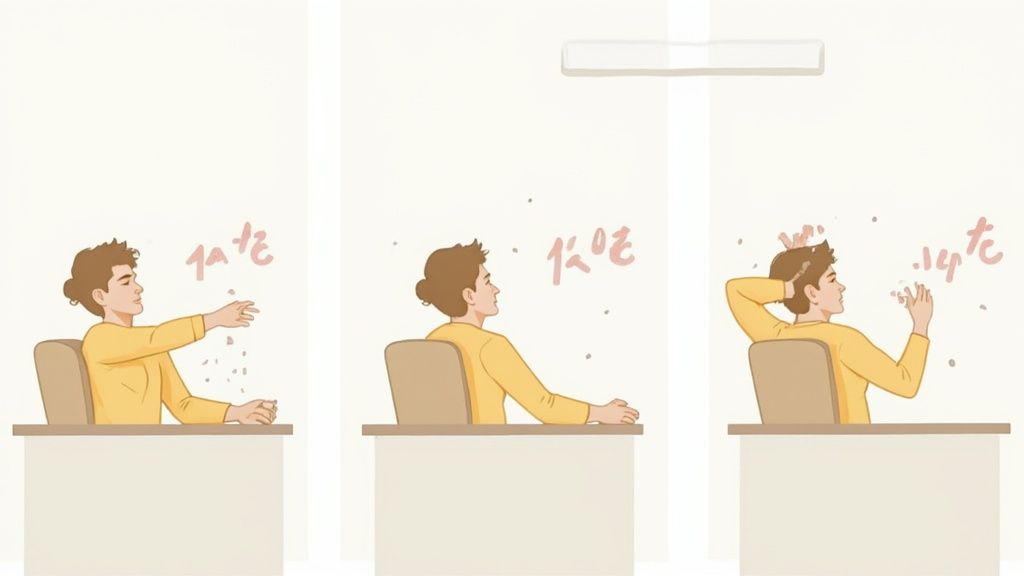Quick Summary
- In under 5 minutes, you can release shoulder tension with simple desk stretches.
- Perfect for busy professionals, beginners, and home workouts—no gym needed.
- Requires minimal equipment: chair, towel, tennis ball (or home swap).
- Step-by-step guidance, form cues, and timing strategies you can fit into your day.
- Track your comfort and range of motion to stay motivated and see real progress.
Quick Moves To Release Shoulder Tension

These three techniques fit into your coffee break or between Zoom calls. Minimal gear, maximum payoff: that’s the goal when you want to release shoulder tension fast.
Comparison Of Relief Methods
Keep this table nearby so you can grab the most effective move in seconds.
Move Details
Fastest Shoulder Roll
Stand tall, lift your shoulders to your ears, then roll them back in a smooth, controlled circle. Repeat for 1 minute, focusing on releasing each trap muscle.Seated Chest Opener
Loop a towel or strap behind you, hold each end at shoulder height, and gently lift your hands to open the chest. Keep your back straight and breathe steadily for 2 minutes.Desk Ball Press
Wedge a tennis ball between your shoulder blade and chair, then lean back to knead out knots. Roll slowly to find tight spots and press for 1–2 minutes.
“A few consistent seconds beat a 30-minute marathon for real relief.”
I often sneak in these microbreaks during conference calls—it feels like hitting the reset button. For those who want to go deeper, check out this guide to using a massage gun for shoulder pain.
Try cycling through all three moves three times a day and jot down which one feels best. Over time, you’ll spot the pattern that keeps your shoulders happy and loose.
Understanding Shoulder Tension
It often sneaks up on you—your shoulders tightening so gradually that one day you wake up to a dull ache. Hours spent hunched over emails, scrolling on your phone, or hauling groceries all chip away at your comfort.
Take Jenna, for example. After a day of writing, she’d feel knots around her neck. Simply raising her laptop to eye level freed up her shoulder blades almost instantly.
Spotting these little habits is your first victory. Try setting a five-minute timer to posture-check and you’ll interrupt tension before it settles in.
- Hunching over your desk while emailing
- Clutching your phone between ear and shoulder
- Slinging a heavy bag on one side
Common Triggers
Repetitive motions are often to blame. Over one-third of workers report shoulder or neck pain each year from tasks like typing and lifting. A meta-analysis of 27 studies involving 12,386 workers backs this up, spotlighting daily activities as a major culprit. Learn more in the meta-analysis report.
Brief stretch breaks aren’t a luxury—they’re your shoulders’ lifeline to stay pain-free.
To get real relief, begin by understanding what causes neck and shoulder tension. From there, you can weave quick posture resets and simple stretches into any part of your day.
Posture Checklist
- Align ears directly over shoulders to ease neck strain
- Roll shoulder blades down and back to open the chest
- Gently engage your core when sitting to support the upper back
With these checks in your routine, you’ll be ready to move more freely and consistently release shoulder tension.
What You’ll Need
You’d be surprised how little gear it takes to ease shoulder tightness—no gym membership required. A simple chair or clear wall corner is enough to get started.
Keep a towel or yoga strap within arm’s reach. It helps deepen those stretches without straining your back. And if you want to zero in on stubborn knots, grab a tennis ball or massage ball.
- Chair or Wall for stable posture support at your desk.
- Towel or Yoga Strap to guide chest-opening and shoulder rotations.
- Tennis Ball or Massage Ball (Optional) for quick self-massage anywhere.
These items slip into a home office setup or even a hotel drawer. No massage ball? A rolled-up sock or tennis ball does the trick just as well.
Equipment Checklist
A gentle tennis ball can help you release shoulder tension in just a minute.
Now, let’s move on to essential stretches designed for all fitness levels.
Essential Shoulder Stretches
Tight shoulders slow everything down—whether you’re typing away at your desk or rushing between meetings. These five beginner-friendly stretches are designed to ease tension, open up key muscles, and boost your range of motion. Along the way, you’ll pick up alignment tips and breathing cues that make each move more effective.
International research puts new shoulder pain cases between 7.7 and 62 per 1,000 people each year. That wide range highlights just how common this issue is—and why a simple daily routine can keep discomfort at bay. For the full breakdown, check out the findings on PMC.
Here’s an infographic mapping the gear needed to start these stretches.

This flowchart shows how a chair, towel, and ball support you to release shoulder tension quickly.
Key Stretch Exercises
Doorway Pec Opener
Face a doorframe, lift your forearms to shoulder height, and gently lean in on your exhale. Feel the chest muscles lengthen and your shoulders drop back. Hold for 30 seconds each side.Seated Eagle-Arm Stretch
Sit tall, wrap one arm under the other, then press palms together. Draw elbows up until they line with your shoulders. Stay for 20 seconds, breathing smoothly before switching sides.Towel-Assisted Flexion
Grab a towel overhead, hands about a foot apart. Walk one hand down the towel to lower that shoulder while the opposite arm stays steady. Hold 25 seconds, then swap.Child’s Pose Shoulder Release
From all fours, sit back on your heels and slide hands forward until your chest rests softly toward the floor. Let your shoulder blades spread wide—hold 40 seconds.Upper Back Ball Roll
Place a small ball under your mid-back while you lie on the floor, feet flat. Gently roll between your shoulder blades, pausing on tight spots for about 1 minute.
Consistent stretching can prevent up to 50% of shoulder pain episodes and help you tackle tension before it builds.
Keep each movement slow and controlled, maintaining a neutral spine so your neck and lower back stay relaxed. As you grow more comfortable, run through the sequence once a day. You’ll notice smoother mobility and fewer tight shoulders holding you back.
Desk-Friendly Shoulder Moves

Feeling like your shoulders lock up after one Zoom call slides into the next? Sneak in mini breaks instead of waiting for lunch. In under five minutes, you can roll back tension without leaving your chair.
Seated Scapular Squeezes
Press your shoulder blades into the chair back as if you’re pinching a pencil between them. Hold for 60 seconds, then release.Gentle Neck Rolls
Let your head drift in a smooth circle three times to ease tightness around your upper traps.Towel-Assisted Rotations
Grab a towel overhead and widen your grip—this opens the chest and releases built-up stress in your shoulders.
Stash a silent timer in your calendar to pop up every hour and guard against stiffness.
If you’re over 50 and on your feet all day, skipping these pauses can let shoulder tension spike. A recent systematic review on older workers highlights this in the Archives of Physiotherapy.
Timing Strategies
Think of these stretches like brushing your teeth—they stick when tied to an existing habit. For instance, pair a scapular squeeze with your coffee refill or do a neck roll at the start of each meeting.
“I slip in these moves between emails, and my shoulders thank me later.”
— Busy Project Manager
Little nudges make a big difference. Jot down your wins in a notes app and watch your posture improve.
- Hourly Vibration Alert: Let your phone remind you every 60 minutes.
- Desktop Sticky Reminder: A note reading “Relieve Shoulder Tension” keeps you honest.
- Habit Stack: Link one stretch to refilling your water bottle.
By weaving these microbreaks into your day, you’ll keep shoulders loose and posture upright without missing a beat.
Common Mistakes To Avoid
It’s tempting to jump into a stretch without minding your posture. But shrugging your shoulders up toward your ears actually locks in tension instead of letting it melt away.
Skipping a quick warm-up feels harmless at first. Yet when your muscles aren’t ready, you end up guarding your shoulders rather than releasing them.
Pushing through back-to-back calls or ignoring microbreaks? By day’s end, you’ll feel every knot you skipped that morning.
Scheduling Pitfalls
- Ignoring Regular Breaks: Waiting until the ache sets in steals your chance to reset.
- Overpacked Calendar: If you don’t carve out even a 60-second pause, tension wins.
- Missing Reminders: In a busy day, you’ll forget to hit “pause” unless something nudges you.
Tie your next shoulder reset to something you already do—like refilling your coffee mug—and the habit builds itself.
Form Flaws
- Hunching your chest pushes shoulders forward and traps tension.
- Overarching your lower back to compensate for tight shoulders.
- Poking your chin forward, which tightens the upper traps.
“A neutral spine and relaxed shoulders are key to releasing tension,” says a certified physical therapist.
Small cues go a long way. A sticky note on your monitor can remind you to drag your shoulder blades down and tuck your chin.
- Pair each movement with a deep inhale and exhale to help muscles soften and your mind unwind.
Avoiding these slip-ups doesn’t take much—just a few tweaks in form and timing. Do it consistently, and you’ll notice looser shoulders week after week.
Progression And Next Steps
When your shoulders start feeling more open, challenge yourself a bit more. Try looping in a resistance band, rolling over a foam roller, or extending each hold by 10–15 seconds. You’ll notice how these tweaks deepen the stretch.
On days when things feel extra tender, switch to gentler options: half-range holds or towel-assisted stretches. Listen closely—your comfort level guides you when to dial up the intensity or back off.
- Resistance Band: Grip the band in front of your chest, step back, and feel a gradual pull across your shoulder blades.
- Foam Roller: Position it under your upper spine and let your chest open as you gently arch over it.
Tracking small gains keeps you motivated. Jot down your weekly arm angle, level of tightness, and any spike or dip in comfort.
Tracking Your Progress
Use these numbers as your baseline. When you see a steady uptick, it’s time to add more reps or hold each stretch a bit longer.
Consistent tracking makes it easier to see small improvements and helps you continue to release shoulder tension over time.
Related Shoulder Workouts
- Upper Back Mobility Flow – A gentle sequence of foam roller thoracic extensions and scapular squeezes.
- Neck Release Drills – Simple head tilts and chin tucks to ease the upper traps.
Stick with this plan and tweak it as needed. Small, steady efforts deliver lasting relief. Gradual progression paired with clear tracking is your ticket to shoulders that stay strong and tension-free.
Ready to keep your shoulders strong and tension-free? Visit Bare Fitness for more routines, guidance, and tips.



















